Lesson 6: theories of cognitive development : Piaget & Vygotsky
1/68
There's no tags or description
Looks like no tags are added yet.
Name | Mastery | Learn | Test | Matching | Spaced |
|---|
No study sessions yet.
69 Terms
Cognition
Activity of knowing and the mental processes used to acquire knowledge and solve problems
Cognitive Development
Changes that occur in cognition/ mental skills and abilities over the course of life.
Two main theorists will be focused on this week:
Jean Piaget
Lev Vygotsky
Piaget’s Theory of Cognitive Development: Key Ideas
Piaget developed genetic epistemology (the experimental study of the origin of knowledge; aka developmental psychology).
Piaget’s theories centered on how children acquire intelligence (i.e., how do we adapt to our environment?).
Goal is to resolve cognitive disequilibrium and achieve cognitive equilibrium.
Piaget viewed the child as a constructivist.
Cognitive disequilibrium
Discomfort caused because what we know to be true does not align with what we see/ Experience in the world
Cognitive equilibrium
When what we know to be true is the same to what we are actually experiencing
constructivist
a learning theory that suggests knowledge is not passively received but actively constructed by the learner through their experiences and interactions
Scheme
are like mental "folders" or "templates" that contain knowledge about specific concepts, objects, situations, or even people
Piaget’s Theory of Cognitive Development: Key Ideas
Cognitive Processes:
Organization
Adaption
Assimilation
Accomodation
Organization
rearranging existing schemes into more complex ones.
Ex. Organizing four legged fluffy thing into cats and dogs
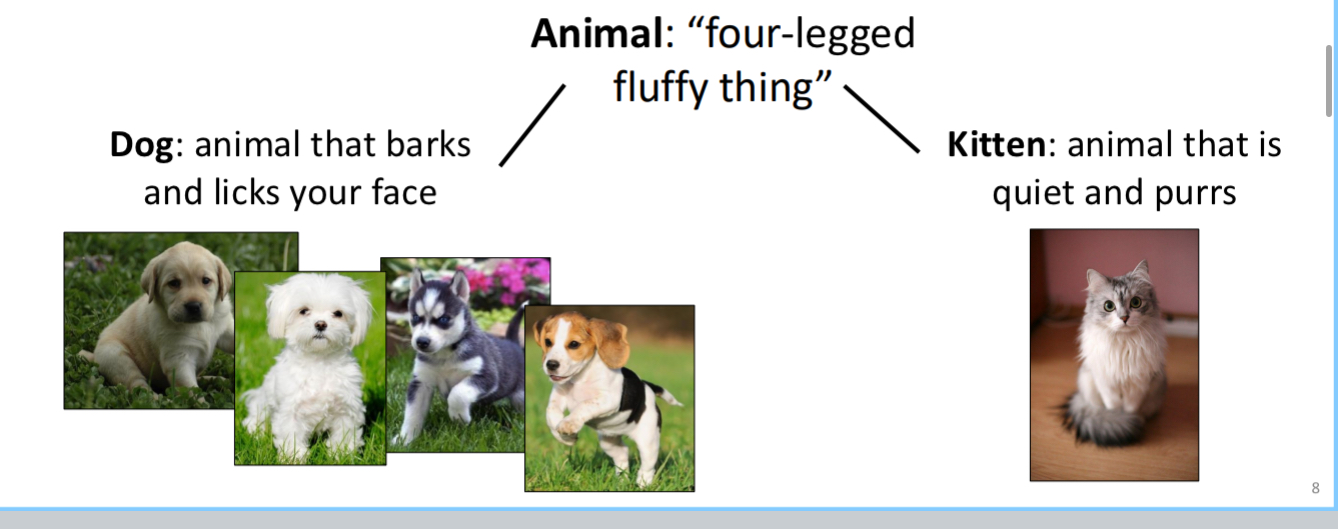
Adaptation:
occurs through assimilation and accommodation.
Assimilation
interpret new experiences with existing schemes.
Cognitive equilibrium achieved because this four legged fluffy thing is the same as what I already know as a dog
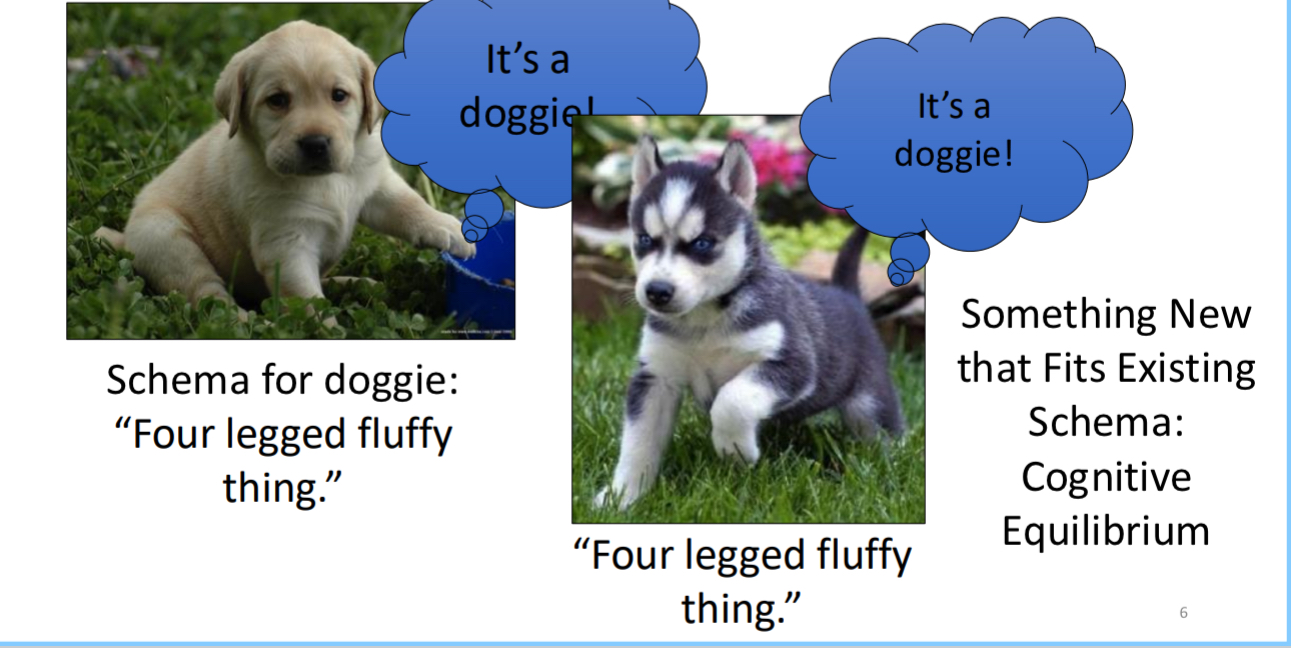
Accommodation:
modify existing schemes to interpret new experiences.
Cognitive disequilibrium → discomfort because this four legged fluffy thing is not a dog
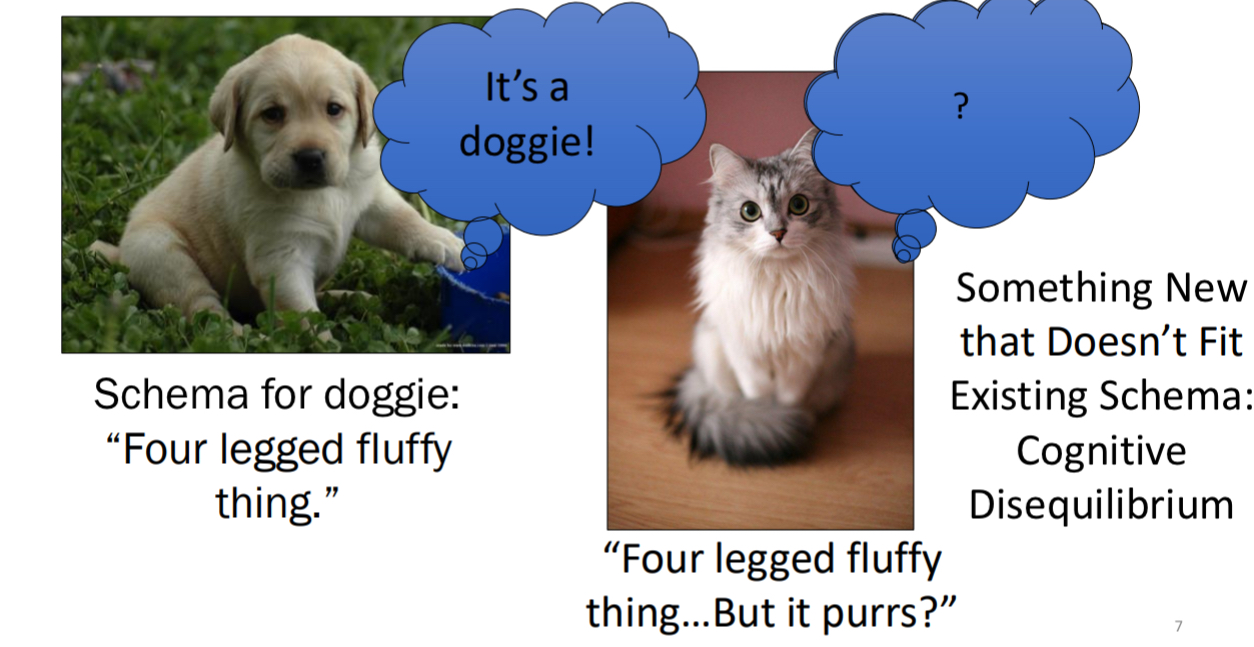
Modifying schemas in Accomodation
Accommodation requires the development of increasingly complex schemas
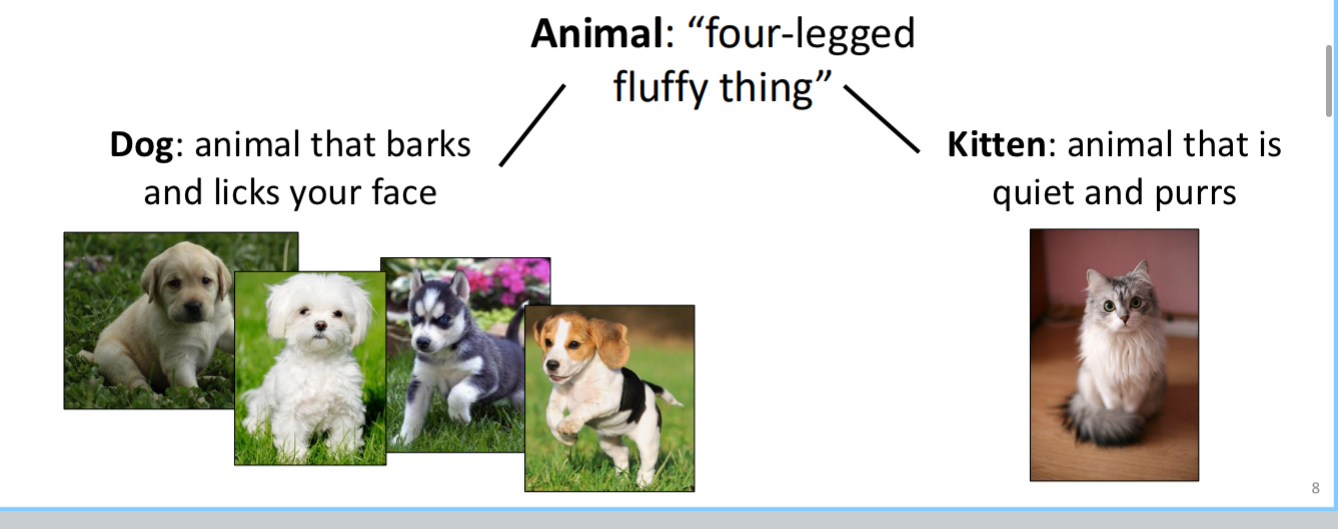
Summary of Piaget’s Key Idea
Goal of intelligence is to create a balance between what we know and what we experience.
Cognitive Equilibration
Cognitive development is motivated by a sense of discomfort when the balance between what we know and experience is disrupted.
Cognitive Disequilibrium
We achieve equilibrium through the process of adaptation and organization.
Brady sees a dolphin for the first time. He points at it and says “fish!”, which he thinks of as an animal that swims in the water. What form of adaptation is he using?
a) Assimilation
b) Accommodation
c) Organization
d) Cognitive Development
a) Assimilation
What is the Piagetian term for an organized pattern of thought or action that the child constructs to make sense of his or her experience?
a) Adaptation
b) Concept
c) Scheme/Schema
d) Accommodation
c) Scheme/Schema
The Four Stages of Piaget’s Stages of Cognitive Development
Sensorimotor (birth to 2 years)
Preoperational (2-7 years)
Concrete Operational (7-11 years)
Formal Operational (11+ years)
Characteristics of Piaget’s stages of cognitive development
Qualitative differences between stages.
Invariant order → everyone progresses in the same order
Universal.
Ages are approximate.
Sensorimotor Stage
0-2yrs
From “reflexive” to “symbolic” thinker
1.1. Reflex Activity (birth to 1 month)
1.2. Primary Circular Reactions (1-4 months)
1.3. Secondary Circular Reactions (4-8 months)
1.4. Coordination of Secondary Schemes (8-12 months)
1.5. Tertiary Circular Reactions (12-18 months)
1.6. Mental Representation (18-24 months)
Reflex Activity
birth to 1 month
“Mindless” exercising of reflexes.
Don’t require thought
Primary Circular Reactions
1-4 months
Use of reflex-based schemes to replicate interesting body-related events.
Infants will discover by chance what their body can do
Usually repeating
Ex. Sucking thumb
Secondary Circular Reactions
4-8 months
Ditto, but interesting object-related events.
By accident infants will discover that they can make object do things
Can differentiate themselves from objects around them
Ex. Make a duck quake, they find this satisfying so they are more likely to do it
Coordination of Secondary Schemes
8-12 months
Intentional goal-directed behaviour.
Combine multiple existing schemes or actions to achieve goals.
Ex. Infant can lift blanket to see object underneath
Needs to lift blanket
And retrieve object under
Tertiary Circular Reactions
12-18 months
Creating interesting events in new ways.
Learn how objects interact with one another and the world.
Trial and error schemes.
Ex. They throw a toy to see what will happen
Mental Representation
18-24 months
No more trial and error.
Inner experimentation.
Summary: Sensorimotor Substage
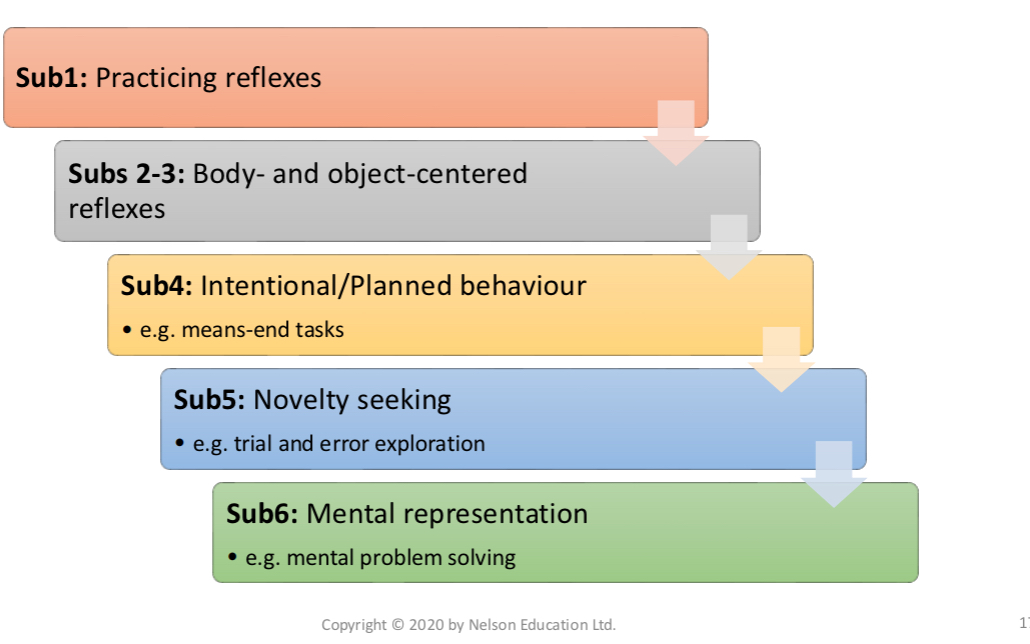
Object permanence:
Understanding that objects continue to exist even when they are no longer visible or detectable through the other senses.
Piaget claimed no object permanence for the first 8 months because of their errors in performance on the A-not-B task
BUT ! Contemporary work (that uses more sensitive measures) confirms that Piaget underestimated young children’s abilities.
A-not-B task
In this task, a desirable object is hidden in one of two locations (A) for several trials. Then, the object is hidden at a new location (B).
Infants below about 8 months of age tend to make the A-not-B error, perseverating and searching for the object at the original location (A) instead of the new location (B), even though they saw it being moved
If something is more interesting / surprising to baby
They will look longer at it because it requires additional attentional processing
If there is difference in looking time between surprising and not surprising stimuli, it violated baby expectations
confirms that Piaget underestimated young children’s abilities.
Renée Baillargeon Work helped prove this
What are operations?
Term used by Piaget that refers to ability to act upon an object in ones mind
The Preoperational Stage
2-7 years
Second stage of Piaget’s theory of cognitive development.
Children now have symbolic function (which facilitates language, and pretend play) but they aren’t yet able to use concrete operations.
Why is symbolic function so important?
Speed to process things (like math problem) increases
scope→ can think about past and present and future. Scope about what they’re ability to talk about increases.
social interaction.
What is the key difference between the pre-operational stage and the sensorimotor stage?
Symbolic representations and mental thinking have developed and are used frequently in the pre-operational stage.
symbolic function
allows children to understand and manipulate objects and ideas that are not physically in front of them
Shortcomings in Preoperational Thought
There are some tasks that children in the preoperational stage are unsuccessful at and that represent the limitations in their thinking.
Some limitations include:
Animism
Egocentrism
Three Mountain Task
Egocentric Speech
Centration
Conservation Tasks
Animism
Attribute lifelike qualities to inanimate object
Ex. My teddy bear is sad, the sun is happy
Egocentrism
Children not good at considering other peoples perspective
Focused on their own perspective and have hard time believing that there is another side to story that is not their own
Three Mountain Task
Setup: A child is seated in front of a table with three model mountains of different sizes, colors, and features (e.g., a cross, a house, snow).
Procedure:
The child is shown different views of the mountains (e.g., from the front, side, or back).
A doll is placed at different positions around the table.
The child is asked to select (from pictures or by arranging models) how the doll sees the mountains.
Key Question: "What does the doll see from its position?"
Younger children typically choose the image matching their own view, failing to recognize the doll’s different perspective can be different than their own
Egocentric speech
Will explain things in a way where child assumes you already know what they are talking about. Won’t introduce characters or give backstories, assumes you already know
Preschool children talk to themselves and narrarate what they are doing and is intended to reflect what child is thinking
At end of pre operational stage, speech will become less egocentric and more social in nature
Centration
Tendency to only focus on most obvious part of a problem
Observed through conservation tasks
conservation tasks
Does child know that change in physical appearance of object result in object remaining the same
Different types
Liquids
Mass
Number
Volume
Liquids conservation tasks
Two identical beakers are filled to the same level, and the child agrees that they have the same amount to drink.
Contents of one beaker are poured into a different-shaped beaker so that the two columns of water are of unequal height.
Child in pre operational stage think that taller glass has more water because they are only focusing on obvious part of problem
Conserving child recognizes that each beaker has the same amount to drink (on the average, conservation of liquids is attained at age 6-7 years).

Mass (continuous substance) conservation tasks
Two identical balls of playdough are presented. The child agrees that they have equal amounts of dough.
One ball is rolled into the shape of a sausage.
Conserving child recognizes that each object contains the same amount of dough (average age, 6-7).

Number conservation tasks
Child sees two rows of beads and agrees that each row has the same number.
One row of beads is increased in length.
Child recognizes that each row still contains the same number of beads (average age, 6-7).
Lack of Success on Conservation Tasks Illustrates Centration in the Preoperational Period

Volume (water displacement) conservation tasks
Two identical balls of clay are placed in two identical beakers that had been judged to have the same amount to drink. The child sees the water level rise to the same point in each beaker.
One ball of clay is taken from the water, molded into a different shape, and placed above the beaker. Child is asked whether the water level will be higher than, lower than, or the same as in the other beaker when the clay is reinserted into the water.
Conserving child recognizes that the water levels will be the same because nothing except the shape of the clay has changed-that is, the pieces of clay displace the same amount of water (average age, 9-12).
Lack of Success on Conservation Tasks Illustrates Centration in the Preoperational Period

Concrete Operational Stage
7-11 years
Third stage of Piaget’s theory of cognitive development.
Children now have more sophisticated schemes that allow them to engage in mental operations.
Children can do concrete things that are right in front of them, not abstract concepts
Children can now engage in:
Reversibility
Egocentrism going down → can take on perspectives of other people
Decentering
Mental seriation
Transitivity
Reversibility
As demonstrated by their success on conservation tasks.
We can go back to original state. Things that happen can be undone. If i move water from cup B to cup C to make it look like there is more water, then I can move water back from Cup C to cup B
Decentering
As demonstrated by their success on conservation tasks.
No longer focuses on most obvious parts of a problem. No longer fails conservation tasks
Look at bigger picture of problems, and take account of different parts of problem
For example in water conservation tasks, they see the water is taller, but also see that class is narrowing. Now they account height and width instead of just height
Mental Seriation
Ability to organize items along a quantifiable dimension
Ex. Can get in line in order of shortest to tallest on their own
the cognitive ability to arrange objects, situations, or concepts in a logical sequence or order, based on a specific attribute like size, weight, or quantity
Ex. Arrange yourself from oldest to youngest
Transitivity
a cognitive process where an individual can infer a relationship between two items based on their shared relationship with a third item
Height: If A is taller than B, and B is taller than C, then A must be taller than C.
What is the key difference between concrete operational thinking and preoperational thinking?
For every limitation of the preoperational child, we see a corresponding strength in the conccrete operational child.
Shortcomings of the Concrete Operational Stage
Logic can only be applied to concrete, real-world objects and events.
Therefore…
Can’t solve abstract, hypothetical problems like algebra
Poor systematic problem solving.
Can’t handle contrary-to-fact premises.
Formal Operational Stage
11+ yrs old
The fourth and last stage of Piaget’s theory of cognitive development.
Formal operational thinkers think more rationally and systematically about abstract concepts and hypothetical events.
Hypothetico-Deductive Reasoning
Inductive Reasoning
They extend operations to abstract identities and hypotheticals, deductive reasoning
Ex. algebra
Ex. contrary-to-fact problems
Children in the formal operational stage can engage in systematic problem solving.
Experimentation → holding variables constant vs. “plunging right in” (without planning or controlling variables, just trying things random)
Piaget’s (1958) pendulum task.
Children are shown a pendulum and asked:
"What makes the pendulum swing faster — the length of the string, the weight, or how hard you push it?"
Goal: See if children can design experiments by varying one factor at a time.
Findings (per Piaget):
Younger children (concrete operational): Tried everything at once (plunged right in), couldn’t isolate variables.
Older children (formal operational): Tested one variable at a time (try all weights for one length of string, then change length of strength and try all the weights for that. The length of string was kept constant to test effects of weight) — showed true scientific reasoning.
Piaget may have overestimated abilities.
E.g., Martorano (1977)
Children in Gr 10 are more than 11 (16 or 17) and only 50% of them were successful in this task
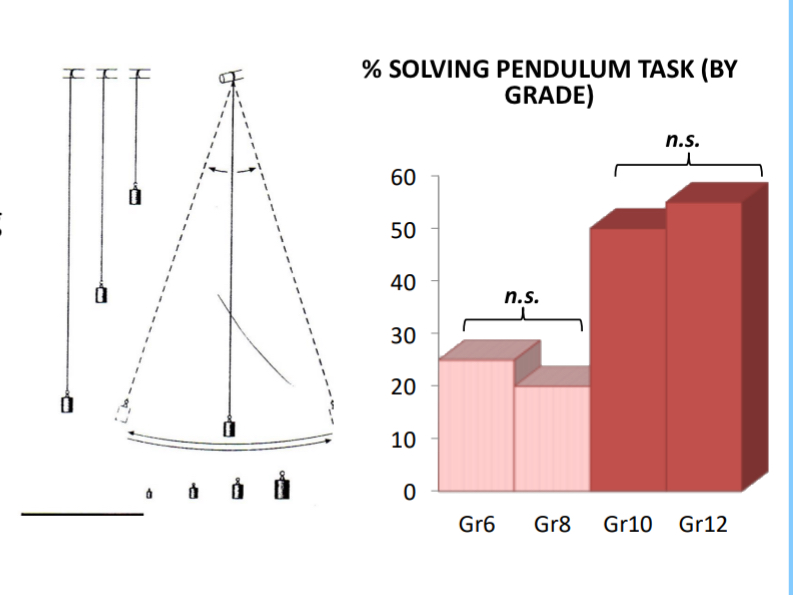
What did Piaget overestimate
formal operational abilities at 11+
What did Piaget underestimate
Object permanence
Hypothetico-Deductive Reasoning
a cyclical process where scientists formulate hypotheses (possible explanations) and then test them through deductive reasoning and experimentation.
Inductive Reasoning
a form of logical reasoning that involves drawing general conclusions or hypotheses based on specific observations or evidence.
contrary-to-fact problems
Difficult with hypothetical scenarios that are contrary to real life
If you tell a child, “all dogs bark”, and then Simon barks, you ask child “is Simon a dog”
Someone in concrete operational stage will fail this and say “yes Simon is a dog”
In formal operational stage child passes, “no Simon is not a dog”
Tell a child “if you hit a glass with a feather the glass will break. John hit a glass with feather, what happened “
Someone in concrete operational stage will fail this and say “the glass did not break because a feather is light.”
In formal operational stage child passes, “the glass will break”
They can work out the hypothetical problem based on the information given, even if it isn’t true to what would happen in real life
But does expertise influence success on formal operations tasks? (De Lisi & Staudt, 1980)
Does individuals expertise influence success on formal operational task
Physics, poly sci and English majors were better with the problem that corresponded with their respective field
Everyone was not always successful
If you were a physics major 90% were successful on the physics / pendulum problem where there was a very drastic less amount of success among the other 2 majors
Yes expertise does influence success on formal operations tasks
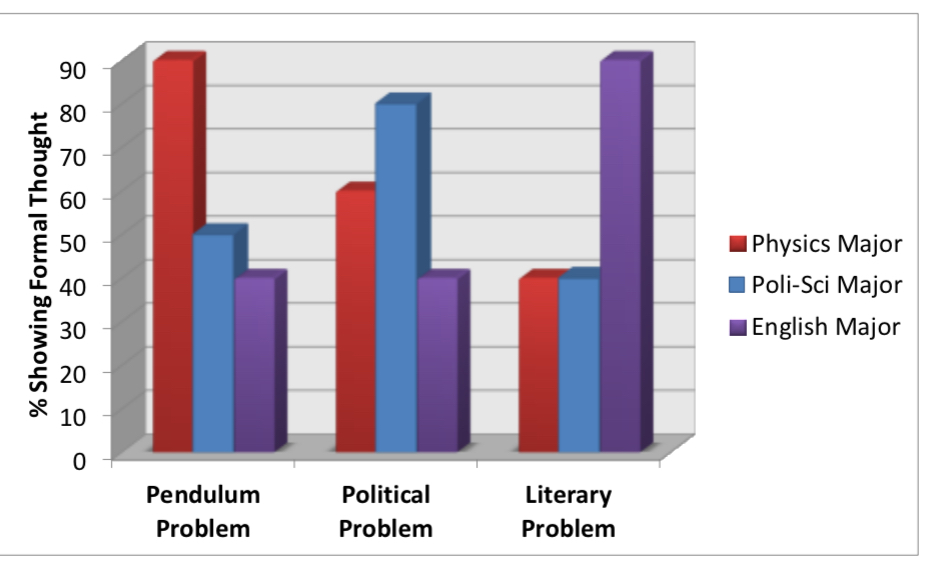
Piaget’s Contribution
Pioneered the study of cognitive development.
Emphasized constructivism→ child plays active roles in constructing their knowledge
Really cool work!
Didn’t just describe development but experience why they were happening
Piaget’s Weaknesses
What are the mechanisms of cognitive change?
How do we explain individual differences and idiosyncrasies (difference between different people, he only looked at general problems)
Undervalues sociocultural environment on development.→ didn’t talk about influence of culture, environment and society
Sally’s mother gives her a glass of milk. She then asks Sally to pour the milk from it’s fat short glass into a tall thin glass. Sally does this and says “Wow! Now there is more milk!”. What stage of cognitive development is Sally in?
a) Sensorimotor
b) Preoperational
c) Concrete Operational
d) Formal Operational
Preoperational
Failure in conservation of liquid task
Natalia’s father has black hair. Natalia thinks that all fathers have black hair. This is an example of:
a) Conservation
b) Disequilibrium
c) Egocentrism
d) Accommodation
Egocentrism
Takes her own perspective and doesn’t see the world in any other way
For Accomodation to happen there needs to be disequilibrium and there is none here
Lev Vygotsky (early 1900s)
Vygotsky developed the sociocultural perspective of development.
Vygotsky believed that development is inseparable from cultural context.
Culture determines which cognitive activities are valued.
Cultural tools shape thought.
Children’s Development is a Shared Journey
Vygotsky believed that children’s development is a shared journey. Children don’t development in isolation
Key concepts include:
Zone of Proximal Development
Scaffolding
Zone of Proximal Development
Area of what child can do with assistance
Ex. 10 month olds can walk if an adult holds their hand
Beyond zone of proximal development
is something that matter how hard I help you you can’t do
Even if I hold a 2 month olds hand, it won’t be able to walk, no matter how hard I help it
Scaffolding
Achieve zone of proximal development through act of scaffolding
Scaffolding is act that is done by mentor (parent, older children)
providing temporary support to learners, like an adult helping a child learn to ride a bike with training wheels, to help them master a new skill or concept within their Zone of Proximal Development (ZPD).
Support that parent gives is adjusted to achieve goal, may start by holding two hands to help infant walk, then only hold one, then no hands.
Private Speech and Inner Speech
Private speech: speaking aloud to oneself, often for self-guidance, problem-solving, or self-regulation
Vygotsky believed that private speech was not egocentric and nonsocial (as Piaget would say), but self regulatory/self- communicative.
Private speech turns into inner speech
More private speech in difficult tasks than simple tasks.